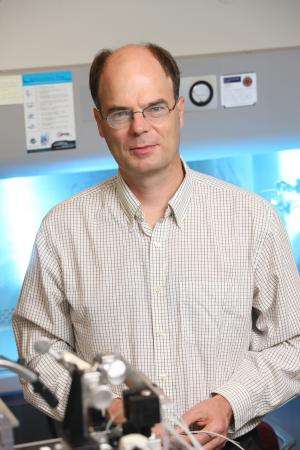Researchers use ultrasound and microbubbles to improve stroke treatment

When University of Virginia biomedical engineering professor John Hossack and colleagues in the School of Engineering and Applied Science and the School of Medicine consider bubbles, they think of something much more useful than a child's plaything or sparkling wine. They are building an entire technology around tiny, microscopic bubbles – a technology that has the potential to play an important role in diagnosing as well as treating disease like stroke and cancer.
"Combining microbubbles with ultrasound gives us a new way to deliver therapeutics where we need them," Hossack said.
These microbubbles are indeed small, measuring from one to five microns in diameter. By contrast, a human hair has a diameter of 100 microns. Because they are so small, they can slip through the smallest passages in the human body – a great advantage from a medical point of view.
Their size, however, is just one of the characteristics that contributes to their potential. Because of the way they vibrate when subject to ultrasound waves, microbubbles can be used to increase the contrast of an ultrasound image, enabling physicians to see features that otherwise would be difficult to discern.
In addition, their oscillations cause membranes in adjacent cells to open. This sets the stage for building a system that uses drug- or gene-carrying microbubbles to deliver therapy at precise locations in the body. Collaborating with Dr. Alexander Klibanov, an associate professor in the Division of Cardiovascular Research and the Department of Biomedical Engineering, Hossack has experimented with using microbubbles to reduce scarring of blood vessel walls after angioplasty.
Hossack and Klibanov have also been developing techniques to use vibrating microbubbles to help break up the clots that cause ischemic strokes. Currently, the treatment of preference is to administer a clot-busting compound, tissue plasminogen activator, within three hours of the first symptoms. When patients miss the time window or when tPA doesn't work, physicians use a catheter-based device to attempt to extract the clot. One danger is that this process can produce smaller clots, which can lodge in smaller blood vessels downstream and beyond the reach of the catheter.
As an alternative, Hossack and Klibanov propose to deliver microbubbles through the catheter to attack these secondary clots. "The microbubbles, in combination with applied ultrasound, accelerate the action of the tPA and help erode the clot," Hossack said. "The fragments that this process produces are too small to do further damage."
Hossack is also working to develop more versatile microbubble technology. The most common method of microbubble production, based on agitation, generates bubbles of varying sizes. If the field is to advance, researchers will need to be able to match bubble size to the application.
Working with Ph.D. student Adam Dixon, Hossack is refining computer chip-based microfluidic devices that when placed on a catheter tip can deliver a stream of uniform microbubbles with precisely controlled diameters.
"Designing a microfluidic device to fit in a microenvironment requires a lot of creative thinking," Hossack said. "But when physicians are in critical situations, they can adjust the size of the bubbles on the spot as circumstances dictate."
Hossack is also working with Klibanov, Ali Dhanaliwala and research scientist Johnny Chen to find ways to increase the microbubble's longevity. An ingenious solution they are developing is to protect them by inserting them into blood cells. One of the advantages of this approach is that it would increase ultrasound contrast anywhere these acoustically active red blood cells travel. Because they are larger, the amount of drug material that each acoustically active red blood cell could carry could be increased as well. The team secured funding from the National Institutes of Health to pursue this research.
"Microbubbles are just one of the promising ultrasound-related projects we're working on in my lab," Hossack said. "We're part of a larger, global movement to capture more of the advantages to be gained using this ultrasound."





















